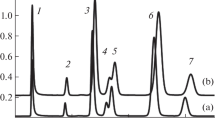Summary
A new parameter, the mean specific plate number, is proposed for assessing the efficiency of support coated open tubular (SCOT) and wall coated open tubular (WCOT) columns and for comparing the efficiency of different open tubular columns. It has the advantage over most previously used parameters in that it has only a small dependence on the partition ratio and it allows for the column diameter.
A graphical presentation is given of the maximum theoretical mean specific plate number as a function of the partition ratio for SCOT columns having a range of relative porous layer thicknesses and for WCOT columns with a range of phase ratios.
This presentation permits ready visual comparison of the potential efficiency of different columns and enables a simple evaluation of the percentage utilization of theoretical efficiency from experimentally determined values of the maximum mean specific plate number. For a given column the percentage utilization of theoretical efficiency at optimum average gas velocity and that at optimum practical gas velocity or at a higher average gas velocity are shown to be equal provided that corrections for column pressure drop are made.
Similar content being viewed by others
Abbreviations
- a:
-
Relative porous layer thickness, d/rg
- B:
-
Longitudinal gaseous diffusion term
- B0 :
-
Specific permeability
- Cg :
-
Term expressing resistance to mass transfer in gas phase
- C1 :
-
Term expressing resistance to mass transfer in liquid phase
- d:
-
Average thickness of porous layer
- df :
-
Average liquid phase film thickness in WCOT column
- Dg0:
-
Diffusion coefficient of solute in gas phase at column temperature and at column outlet pressure
- D1 :
-
Diffusion coefficient of solute in liquid phase at column temperature
- f:
-
Giddings gas compressibility factor 9(P4−1)(P2−1)/8(P3−1)2
- F:
-
Ratio of liquid phase surface area in SCOT column to that in equivalent WCOT column
- G:
-
Dimensionless number in theoretical equations for Cg
- h :
-
Reduced plate height, h/2rg
- h, HETP:
-
Height equivalent to theoretical plate
- H, HEETP:
-
Height equivalent to effective theoretical plate
- j:
-
James-Martin gas compressibility factor, 3(P2−1)/2(P2−1)
- j′:
-
Guiochon gas compressibility factor, 3(P2+2P+1)/4(P2+P+1)
- k:
-
Partition ratio
- K:
-
Partition coefficient
- L:
-
Column length
- L:
-
Dimensionless number in theoretical equations for C1
- M:
-
Mean specific plate number
- n:
-
Number of theoretical plates
- n0 :
-
Geometric mean of n and N
- N:
-
Number of effective theoretical plates
- N:
-
Arithmetic mean of n and N
- opgv:
-
Optimum practical gas velocity
- opt:
-
Optimum, refers to conditions where h is minimum
- pi :
-
Carrier gas absolute pressure at column inlet
- p0 :
-
Carrier gas absolute pressure at column outlet
- Δp:
-
Pressure drop along column
- P:
-
Pressure ratio, pi/po
- r:
-
Inside radius of column tube
- rg :
-
Radius of free gas passage
- SCOT:
-
Support coated open tubular (column)
- ū:
-
Average linear carrier gas velocity
- UTE%:
-
Percent utilization of theoretical efficiency
- WCOT:
-
Wall coated open tubular (column)
- β:
-
Phase ratio
- η:
-
Carrier gas viscosity at column temperature
- θ:
-
Ratio of average carrier gas velocities
- E:
-
Experimental value
- T:
-
Theoretical value
References
L. S. Ettre, Open Tubular Columns in Gas Chromatography, Plenum Press, New York, 1965.
L. S. Ettre andJ. E. Purcell, Advances in Chromatography,J. C. Giddings andR. A. Keller, eds., Marcel Dekker, New York,10, 1 (1974).
D. H. Desty, A. Goldup andW. T. Swanton, Gas Chromatography,N. Brenner, J. E. Collen andM. D. Weiss, eds., Academic Press, New York, 1962, p. 105.
M. J. E. Golay, Anal. Chem.29, 928 (1957).
J. C. Giddings, J. Chromatog.13, 301 (1964).
D. C. Horne, J. H. Knox andL. McLaren, Separation Science1, 531 (1966).
L. S. Ettre, E. W. Cieplinski andW. Averill, J. Gas Chromatog.1 (2), 7 (1963).
G. Guiochon, Advances in Chromatography,J. C. Giddings andR. A. Keller, eds., Marcel Dekker, New York,8, 179 (1969).
A. B. Littlewood, Anal. Chem.38, 2 (1966).
M. J. Golay, Gas Chromatography,D. H. Desty, ed., Butterworths, London, 1958, p. 36.
M. J. E. Golay, Nature199, 370 (1963).
M. J. E. Golay, Anal. Chem.40, 382 (1968).
S. J. Hawkes, J. Chromatog.68, 1 (1972).
S. J. Hawkes, J. Chromatog.124, 359 (1976).
E. N. Fuller andJ. C. Giddings, J. Gas Chromatog.3, 222 (1965).
T. R. Marrero andE. A. Mason, J. Phys. Chem. Ref. data 1, 3 (1972).
C. R. Wilke andP. Chang, Am. Inst. Chem. Engr. J.1, 264 (1955).
W. Billen andS. Hawkes, J. Chromatog. Sci.15, 148 (1977).
I. Brown, Chromatographia, in press.
D. H. Desty andA. Goldup, Gas Chromatography,R. P. W. Scott, ed., Butterworths, London, 1960, p. 162.
L. Blomberg, Chromatographia8, 324 (1975).
M. J. Hartigan andL. S. Ettre, J. Chromatog.119, 187 (1976).
L. S. Ettre, unpublished data.
J. D. Schieke andV. Pretorius, J. Chromatog.132, 223 (1977).
Author information
Authors and Affiliations
Rights and permissions
About this article
Cite this article
Brown, I. The efficiency of open tubular gas chromatographic columns. Chromatographia 12, 265–270 (1979). https://doi.org/10.1007/BF02261827
Received:
Revised:
Accepted:
Issue Date:
DOI: https://doi.org/10.1007/BF02261827




